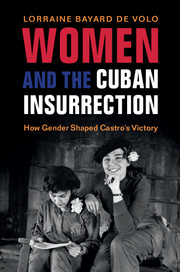Book contents
- Women and the Cuban Insurrection
- Women and the Cuban Insurrection
- Copyright page
- Dedication
- Contents
- Preface
- 1 Revolution Retold
- 2 “How Can Men Tire When Women Are Tireless?”
- 3 A Movement Is Born
- 4 Abeyance and Resurgence
- 5 Gendered Rebels
- 6 War Stories Celebrated and Silenced
- 7 “Stop the Murders of Our Children”
- 8 Masculinity and the Guerrilla War of Ideas
- 9 Women Noncombatants
- 10 Las Marianas
- 11 Past Is Prologue
- Bibliography
- Index
9 - Women Noncombatants: Multiple Paths and Contributions
Published online by Cambridge University Press: 19 January 2018
- Women and the Cuban Insurrection
- Women and the Cuban Insurrection
- Copyright page
- Dedication
- Contents
- Preface
- 1 Revolution Retold
- 2 “How Can Men Tire When Women Are Tireless?”
- 3 A Movement Is Born
- 4 Abeyance and Resurgence
- 5 Gendered Rebels
- 6 War Stories Celebrated and Silenced
- 7 “Stop the Murders of Our Children”
- 8 Masculinity and the Guerrilla War of Ideas
- 9 Women Noncombatants
- 10 Las Marianas
- 11 Past Is Prologue
- Bibliography
- Index
Summary
Women comprised about 5 percent of the Cuban guerrilla in the Sierra by late 1958, most serving in rearguard positions. Although the women combatants (discussed in the following chapter) have received much of the attention, most women rebels in the Sierra were not combatants and did not carry rifles. Rather, they worked in areas such as couriers, teachers, nurses, and cooks. Che Guevara's globally influential writings on guerrilla warfare, which lauded women's contributions while channeling them into feminized tasks, have served as a primary source for guerrillas and scholars alike. Accordingly, I examine them here as a means of organizing and analyzing the diverse and sometimes contradictory messages about Cuban women's actual and proper participation in guerrilla warfare. I then trace women's paths into the guerrilla forces, finding that they were ideologically drawn to the rebels, pushed by the repression, and called up from the llano for their skills. There were also class distinctions in the work assigned to women. Growing numbers of relatively well-educated middle- and upper-class women were forced from the llano to the relative safety of the guerrilla camps. Instead of the low-status feminine work of cooking and cleaning, these women helped replace the state in guerrilla-controlled regions, supplying rebel tax collection, education, and healthcare. I argue this to be another aspect of the hearts and minds campaign, providing incentives for civilians to collaborate and increasing their support for the rebels' vision of governance.
Che in Love and War
A primary argument barring women from militaries is that their presence will distract men and lead to sexual tensions. Accordingly, before examining women's noncombatant contributions, I first consider heterosexual relations in the Sierra. Che, as archetype of guerrilla machismo and author of the how-to handbook on guerrilla warfare, was both a model and catalyst for revolutionary movements elsewhere. His own relations with women in the guerrilla as well as his writings on the role of women in the struggle are thus a productive though underexamined starting point.
In his guerrilla diary, in the rare instances Che writes of specific women, he evaluates them on more personal terms than he does men.
- Type
- Chapter
- Information
- Women and the Cuban InsurrectionHow Gender Shaped Castro's Victory, pp. 189 - 209Publisher: Cambridge University PressPrint publication year: 2018

